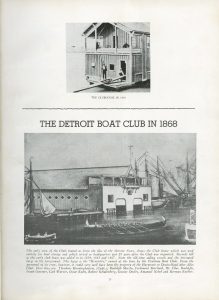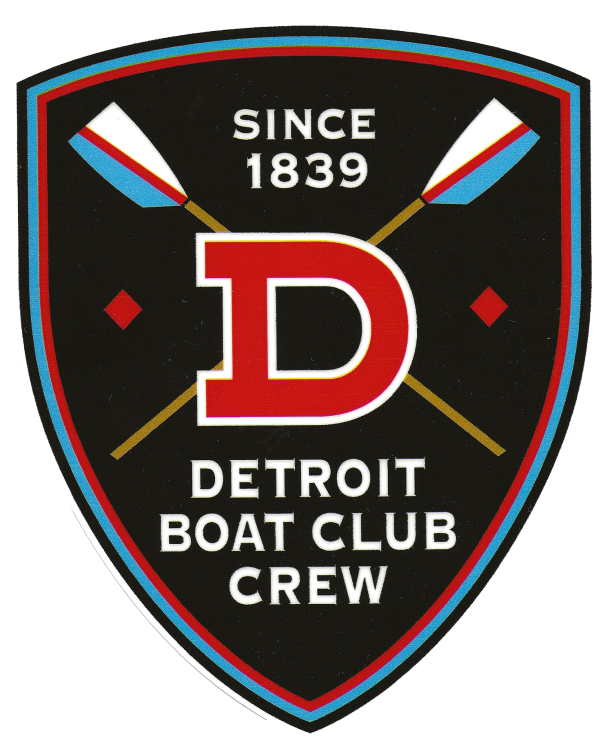Overview
The Detroit Boat Club Crew (DBCC), founded in 1839, is one of the world’s oldest rowing organizations in continuous existence. The crew’s most recent home, the Belle Isle Boathouse was built in 1902 and was actually the group’s sixth boathouse on the Detroit River. Currently, the DBCC operates on the same property and is beginning construction of a new boathouse.
Throughout its history the Detroit Boat Club Crew has consistently enjoyed success on the local, national, international, and Olympic levels.
With FODR sponsorship, DBCC rowers routinely compete in national and international events where they develop the skills necessary to excel at the next level. DBCC high school graduates regularly attend some of the best schools in the nation – both academic and competitively in the sport of rowing.
The Detroit Boat Club is the last surviving historic rowing boathouse on the Detroit River out of the nearly 70 rowing clubs that have dotted the Detroit River’s shoreline over the last 190 years.
It has counted among its membership the likes of automotive pioneers Henry and Edsel Ford and Ransom E. Olds, no fewer than eight mayors – including Hazen S. Pingree – as well as five senators, a congressman, presidential cabinet members, and many other figures in Detroit and U.S. history.
Until recently, the building was occupied continuously for the last 121 years by the Detroit Boat Club Crew, the second oldest rowing program in the United States and the fourth oldest club in the world. The building is no longer affiliated with the Detroit Boat Club and is now operated under the sponsorship of Friends of Detroit Rowing. The Detroit Boat Club Crew has produced more than 500 U.S. and Canadian national champions, 19 Olympians, and 35 National Team members who have represented the United States at the world championships. All of whom have rowed from this boathouse.
Because the club’s two previous wood-framed clubhouses were destroyed by fire, this one was made from brick and concrete, and it’s one of the oldest surviving concrete structures in the country. It is the seventh home the Detroit Boat Club built for itself in Detroit.
Our History
1838 – 1850
August 23, 1856
A rowing club is founded by George A. Baker, James T. Baker, Warham S. Brown, Joseph M. Brown, Thomas S. Gillet, Samuel E. Pittman, Benjamin Franklin Baker, F. Buttrick, Thomas Sheldon, N. G. Bostwick, An. N. Rood, H. B. Reeve and Selah V. Reeve. Warham S. Brown was elected president; George A. Baker, vice-president; Samuel E. Pittman, secretary and treasurer; and James T. Baker, coxswain.
August 26, 1856
The new rowing club adopts a club constitution and formally organized under the name of the Detroit Boat Club. All members of the old Detroit Boat Club are placed on an honorary list.
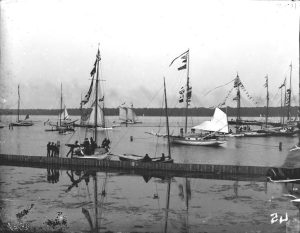
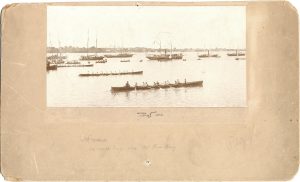
1856-1858
Edmund Brush donates the Frolic to the new organization, which becomes the club’s first boat, and is re-christened the E. A. Brush, after Brush. It is soon joined by a new six-oared barge, purchased by the club. The E. A. Brush is later stored in Brush’s boat house at his Grosse Pointe estate, where it stayed until his death in 1877.
Space is rented out of a carpentry shop off of Atwater Street between Rivard and Hastings Streets. The five-foot high crawl space under the shop became the boat room and a room above the shop became the dressing room. Meetings were held in the office of the draughtsman of the Detroit & Milwaukee Railroad.
September 1857
The famous eight-oared DBC barge Camilla is purchased from Chris Thoms of New York. This boat was saved by the club as a “trophy of the past” until it burned in the 1893 boat house fire.
Fall 1858
A new boat house is constructed at the wharf of Edmonds, North & Co., located at the corner of Hastings and Atwater streets. The boat room was fifty feet long, twenty-five feet wide, and eight and a half feet high, containing two windlasses for hoisting boats in and out of the water, racks for oars and boat-hooks along the walls, and a large closet for tools. The second floor was twenty feet long, twelve feet wide, and eight feet high, and was used as the dressing room with lockers for the members.
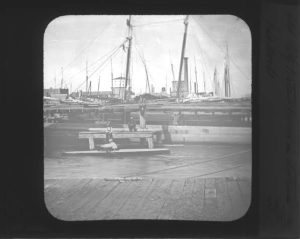
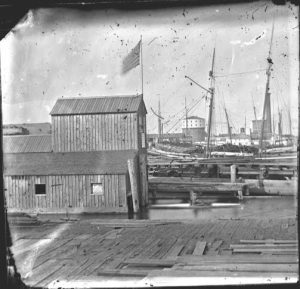
December 1858
Four promenade concerts were held at the Russell House to raise funds to pay for the new boat house. These concerts drew “the elite” of the city and were “long remembered as marked social events.” They were successful, raising the $250 needed to pay off the club’s debt with enough left over to donate $25 to the Industrial School, located at the corner of Grand River Avenue and Washington Boulevard.
Winter 1858 – 1859
Boats are stored in the new building for the first time, being housed on stretchers “one above the other.”
1859
A twelve mile race from the boat house to Grosse Ile takes place between the E. A. Brush, steered by Ben. Baker, and the Camilla, commanded by Joe Brown. The crew of the Brush won, no times were recorded.
The boat house is enlarged to accommodate new boats.
1863
Despite many members being enlisted in the Army for the Civil War, the club was still listed as being “in a flourishing condition.” The boat house is again enlarged.
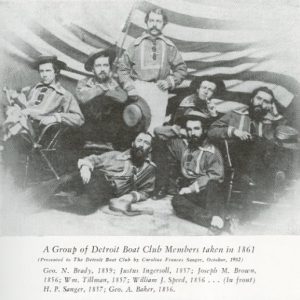
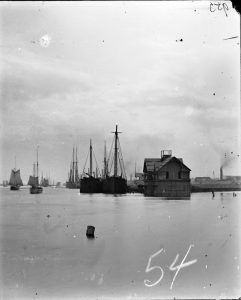
January 26, 1865
The club hosts its first ball in three years (due to the War) at the Russell House, attracting 400 guests who paid $5 a ticket, that included Mayor Kirkland C. Barker, a number of city officials and “a distinguished assemblage of Army officers.” Guests came as far as Monroe, Saginaw and Toledo.
1867
The club orders a new six-oared, 50-foot shell and a four-oared, 40 foot lapstreak from New York boat builder James Mackay. Another addition is tacked on to the boat house to accommodate the new boats.
August 12, 1867
Following the founding of a handful of other rowing teams, local oarsmen join together and form the Detroit River Navy. This organization would govern rowing traffic on the river, as well as host reviews, social events and races.
October 3, 1867
What is believed to be the first time an out of state crew visited Detroit to race. The Milwaukee Boat Club of Milwaukee, Wisconsin challenged the DBC in late September to race a friendly match between the six-oared lapstreak Milwaukee boat Kionickinnick and the DBC six-oared lapstreak Haidee. The race was a total of three miles, that was raced one and a half miles upstream from a point opposite the Detroit & Milwaukee Railroad dock, turn around a stake boat opposite Wight’s sawmill, and return. The DBC boat lost with a time of 25 minutes, 15 seconds behind the Milwaukee boat. Detroit treated their guests to dinner at the Russell House, the evening being filled with speeches and toasts in honor of the health of each club.
